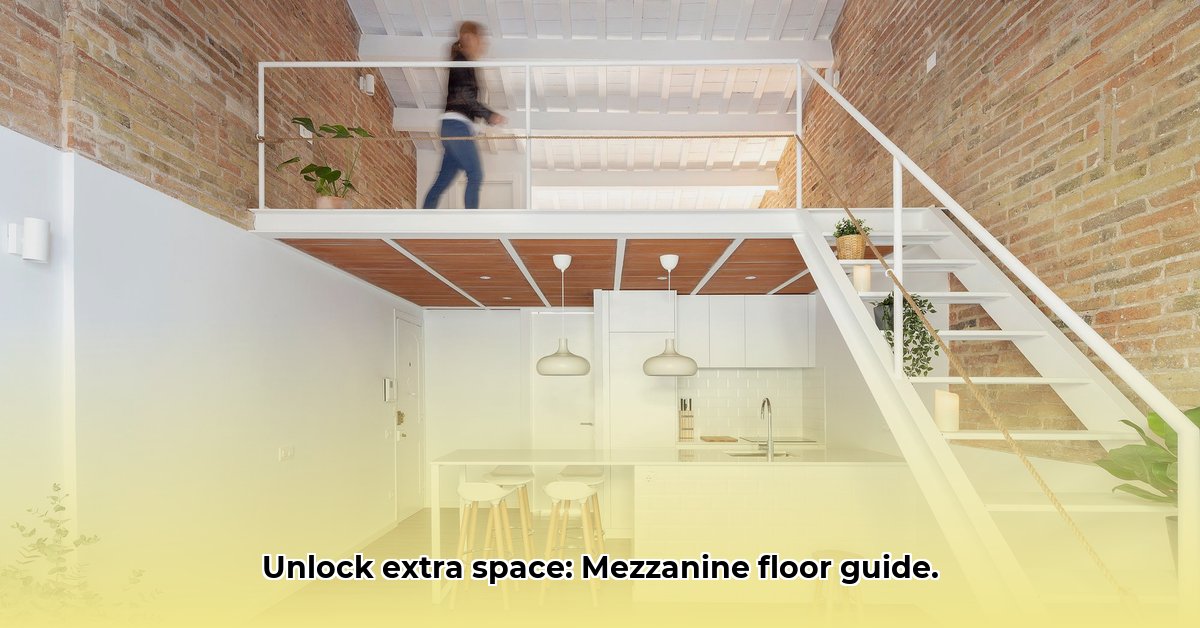Running out of room in your building? Adding a second story can be incredibly expensive and time-consuming. However, there’s a simpler, more affordable solution that’s often overlooked: a mezzanine floor. Think of it as a second floor built *inside* your existing space. Mezzanines are a cost-effective way to expand usable square footage without the major construction hassles. This comprehensive guide will walk you through everything you need to know about mezzanines, including: defining what they are, exploring the various types available (steel, wood, concrete, and more!), understanding how to design one safely and efficiently, and detailing the installation process. We’ll also cover essential topics like cost considerations, regulatory compliance, and ongoing maintenance to ensure longevity. Whether you’re aiming to maximize warehouse storage, create additional office space, expand your retail footprint, or simply gain more room to operate, a mezzanine might be the perfect solution. Let’s explore whether it’s the right fit for your needs!
Understanding Mezzanine Floors
What exactly is a mezzanine floor, and what are the key benefits they offer for businesses? The core concept is adding an intermediate floor level within an existing structure, effectively creating a partial second story inside your current building. As such, it’s a smart way to leverage unused vertical space, transforming it into valuable office areas, storage solutions, retail displays, or even expanded production lines. Unlike full-scale building expansions, mezzanines offer a less disruptive and more budget-friendly path to increased capacity. This guide provides a deep dive into everything you need to know about mezzanine floors, from initial design and material selection to installation best practices and long-term maintenance considerations.
Exploring the Spectrum: Types of Mezzanine Floors
There are several distinct types of mezzanine floors, each tailored to specific applications, structural requirements, and budgetary constraints. Understanding these different types allows you to select the optimal solution for your particular needs:
- Steel Mezzanine Floors: Renowned for their exceptional strength and versatility, steel mezzanines are well-suited for heavy-duty applications such as warehouses, manufacturing plants, and distribution centers. The inherent robustness of steel, coupled with its relatively straightforward assembly process, makes it a popular choice for industrial settings. While steel mezzanines tend to have a higher initial cost compared to other options, their long-term durability and load-bearing capabilities often justify the investment.
- Wood Mezzanine Floors: Wood mezzanines offer a more aesthetically pleasing alternative, frequently employed in retail environments, office spaces, and other settings where visual appeal is a priority. These mezzanines are typically more budget-friendly upfront, but they require diligent maintenance to mitigate the effects of moisture, pests, and other potential sources of damage. Wood’s relatively lower load capacity also limits its suitability for heavy-duty applications.
- Concrete Mezzanine Floors: For applications demanding exceptional strength, durability, and resistance to vibration, concrete mezzanines are the ideal choice. These mezzanines are commonly found in heavy industrial facilities, data centers, and other environments that require the ability to support extremely heavy loads. However, the installation of concrete mezzanines is significantly more complex and costly than other options, necessitating specialized equipment and expertise.
- Rack-Supported Mezzanines: Rack-supported mezzanines integrate seamlessly with existing pallet racking systems, leveraging the racking structure to provide support for the mezzanine floor. This design is particularly well-suited for warehouses and distribution centers with high-density storage requirements. Rack-supported mezzanines offer a cost-effective way to expand storage capacity without the need for additional structural supports.
- Custom Mezzanines: Tailored to match specific space and capacity needs, offering maximum flexibility and strength.
- Modular Mezzanines: These pre-engineered systems offer a balance of cost-effectiveness and ease of installation.
| Type | Advantages | Disadvantages | Best Uses |
|---|---|---|---|
| Steel | High strength, adaptable design, relatively quick installation, durable | Higher initial cost compared to wood | Warehouses, factories, heavy industrial settings, distribution centers |
| Wood | Aesthetically pleasing, more affordable upfront, can be easily customized | Requires more maintenance, lower load capacity compared to steel and concrete, susceptible to moisture and pests | Retail spaces, offices, lighter-duty environments, showrooms |
| Concrete | Extremely strong, very durable, excellent vibration damping, fire-resistant | Difficult and expensive installation, limited design flexibility, can be difficult to modify after installation | Heavy industrial applications, high-load areas, data centers, environments requiring vibration control |
| Rack-Supported | Cost-effective, integrates seamlessly with existing racking systems, maximizes space utilization | Limited design flexibility, load capacity dependent on racking system, may require modifications to existing racks | Warehouses, distribution centers with existing pallet racking systems, high-density storage environments |
| Custom | Optimized for specific needs, maximizing space utilisation, tailored for unique operational needs | Can be more expensive and require longer lead times | Facilities requiring unique solutions, specialized industries, areas with challenging layouts |
| Modular | Cost effective, quick installation, easy to reconfigure | Limited customization compared to custom mezzanines, may not be suitable for extremely heavy loads | Storage areas, offices, retail spaces needing flexible solutions |
Key Design Considerations: Load Capacity, Structural Design, and Access Points
Thorough planning is paramount to the success of any mezzanine floor project. Proper design takes into account a multitude of factors, from load-bearing capabilities to safety compliance. Here are the crucial design aspects for optimal mezzanine design:
- Load-Bearing Capacity: Accurately calculating the maximum weight the mezzanine floor can safely support is of utmost importance. This calculation must account for both static loads (the weight of permanently stored items) and dynamic loads (the weight of moving equipment and personnel). Underestimating the load-bearing capacity can lead to catastrophic structural failure and poses a significant safety hazard. A structural engineer should perform appropriate load calculations based on the mezzanine’s intended use.
- Structural Design: The structural design of the mezzanine floor must adhere to all applicable local building codes and safety regulations. This typically involves working with a qualified structural engineer who possesses in-depth knowledge of local building codes and requirements. The engineer will develop detailed plans and specifications that ensure the structural integrity and stability of the mezzanine.
- Access Points: Providing safe and convenient access to the mezzanine floor is essential for efficient operations and worker safety. Access options include stairs, ramps, and personnel lifts. The choice of access method should be based on factors such as the size and layout of the mezzanine, the frequency of access, and any accessibility requirements. All access points must comply with applicable building codes and safety regulations, including those pertaining to stair design, handrail height, and slip resistance.
- Safety Features: Incorporating appropriate safety features into the mezzanine design is critical for preventing accidents and protecting workers. Guardrails, safety netting, and adequate lighting are essential safety components. Guardrails should be installed along all open edges of the mezzanine to prevent falls. Safety netting can be used to protect workers from falling objects. Adequate lighting is necessary for safe navigation and task performance.
- Fire Safety: The mezzanine design must comply with all applicable local fire codes. This may involve the installation of sprinkler systems, fire-resistant materials, and clearly marked emergency exits. A fire safety engineer can assess the specific fire hazards associated with the mezzanine and recommend appropriate fire protection measures.
Installation: Site Preparation, Framing, and Finishing Touches
While some smaller, simpler mezzanine projects may be suitable for DIY installation, professional installation is strongly recommended, particularly for larger or more complex structures. Professional installers possess the expertise, equipment, and insurance necessary to ensure proper compliance with safety codes and a longer-lasting outcome. Here’s a quick overview of the installation process to better understand the steps involved:
Step 1: Site Preparation: The installation site must be thoroughly prepared to provide a solid, level base for the mezzanine structure. This may involve clearing existing obstructions, leveling the floor, and reinforcing the existing structure to support the weight of the mezzanine.
Step 2: Framing and Support: The main structural frame of the mezzanine is erected, carefully following the engineer’s plans and specifications. This step requires precision and attention to detail to ensure the structural integrity of the mezzanine.
Step 3: Decking Installation: Once the frame is securely in place, the floor decking is installed. The type of decking material used will depend on the intended use of the mezzanine and the load-bearing requirements.
Step 4: Finishing Touches: The final step involves adding finishing touches such as railings, stairs, lighting, and other safety components. These elements are essential for ensuring the safety and functionality of the mezzanine.
Maintenance and Inspections: Ensuring Safety and Longevity
Regular inspections and proactive maintenance are essential for extending the lifespan of your mezzanine floor and ensuring the safety of its occupants. This involves regularly checking for any signs of damage, loose parts, or wear and tear on safety elements. Promptly addressing any issues that are identified can prevent minor problems from escalating into major repairs or safety hazards. Industry data suggests that proactive maintenance can extend the lifespan of a mezzanine floor by up to 25%.
Budget Considerations: Estimating Mezzanine Costs and ROI
The total cost of a mezzanine floor project can vary drastically depending on a number of factors, including the
- Glass Tile Shower Ideas to Create a Stunning Bathroom Space - December 7, 2025
- Glass Wall Tile Ideas for Kitchens and Bathrooms - December 6, 2025
- Glass Tile Bathroom: Create a Beautiful, Easy-Clean Space - December 5, 2025










